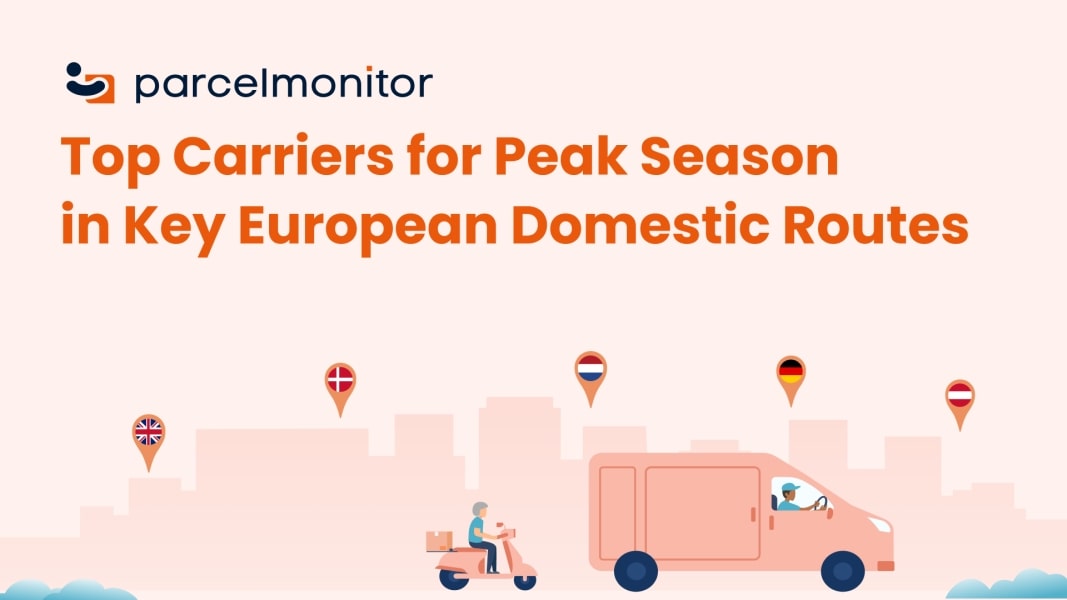Top carriers for 2024 peak season in key European domestic routes
Written by
Editorial TeamPublished on
Discover the top-performing carriers for 2024’s peak season across key European domestic routes. As e-commerce continues to rise, ensuring timely and efficient deliveries is crucial for customer satisfaction— find out which carriers are leading the way and how they can help your business thrive during the busiest shopping season of the year. (Ad)

(Image Source: Parcel Monitor)
Commercial collaboration
The European e-commerce logistics market is an important part of the region’s rapidly expanding e-commerce sector. With the growth of online shopping platforms and the growing preference for digital transactions, the demand for efficient and dependable logistics services has increased. This is particularly true during the peak season.
According to recent reports, European e-commerce sales are estimated to reach $745 billion by the end of 2024, with the market rising at an 8% compound annual growth rate (CAGR) to about $951 billion by 2029. This constant growth highlights the increasing value of strong logistical networks in Europe to meet the recent surge in online purchasing. Furthermore, the COVID-19 epidemic has irrevocably hastened the move to online purchasing, demonstrating the significance of dependable domestic delivery systems to match customer expectations during peak shopping seasons.
Understanding the performance of multiple carriers in domestic trade lanes is critical for European businesses seeking to ensure customer satisfaction and preserve a competitive advantage. This article examines the top carriers for important domestic trade routes in Europe based on last year’s peak season performance.
Top Carriers in European Domestic Shipping Routes
Germany to Germany (DE to DE)

(Image Source: Unsplash)
The e-commerce sector of Germany is expected to reach €136.80 billion by 2029, growing at an annual growth rate of 8.45%, according to forecasts. Effective domestic trade is essential to sustaining the nation’s economic growth, particularly during peak seasons.
DHL‘s outstanding performance includes a high on-time delivery rate of 94.7% and a low transit time of 1.37 days. Their excellent performance enhances the business’s reputation and has a direct influence on customer happiness.
With a 10.87% issue ratio, GLS is more likely to have delivery issues and potential customer dissatisfaction. Their lower on-time ratio of 90.74% and lengthier transit time of 1.47 days may worry businesses that value dependability and quickness.
With a 3.57% collection point ratio and a 91.93% first-attempt success ratio, DPD places a high priority on house deliveries, which may appeal to businesses during peak season. Although their first-attempt success ratio is remarkable, it is less than DHL’s rate of on-time delivery.
Netherlands to Netherlands (NL to NL)

(Image Source: Unsplash)
The Netherlands‘ e-commerce scene is ranked 20th globally and in the top 10 in Europe. The e-commerce market is projected to increase at a CAGR of 9.31%, from its predicted €30.5 billion in 2024 to €47.5 billion by 2029.
PostNL leads the Dutch market with an average transit time of 1.11 days, a first-attempt success ratio of 97.73%, and an exceptional on-time ratio of 97.74%. This outstanding performance demonstrates consistency in service quality, which may considerably cut customer service overheads while improving brand reputation.
DHL has quick transit times of 1.07 days and a first-attempt success rate of 98.62%, making it suitable for home-based businesses. Their exceptionally low collection point ratio of 0.2% indicates a significant emphasis on direct deliveries, which is beneficial for businesses that target home-based customers.
Despite providing comparable transit times, DPD has a higher issue ratio of 11.01%, showing a need for improved dependability. This increasing frequency of delivery difficulties may result in higher customer service demands and associated expenses for businesses that use their services.
United Kingdom to United Kingdom (GB to GB)

(Image Source: Unsplash)
With a population of over 69 million and a high Internet penetration rate of 97.8%, the United Kingdom boasts a big and profitable online consumer base for both domestic and international businesses.
Royal Mail is a major participant in UK logistics. It shows a 1.26-day transit time and a 98.24% on-time ratio despite a moderate issue ratio of 6.41%, which may result in difficult deliveries owing to the large volume.
DPD is a leading logistics company with a 1.14-day transit time and a 97.63% first-attempt success rate, ensuring speed and dependability. Its good performance in first-attempt deliveries implies that customers are more likely to receive their packets on time, which increases customer satisfaction.
Evri is a speedier choice for businesses that deliver less time-sensitively. It provides a transit time of 2.5 days and a first-attempt success ratio of 97.48%. This high success rate might help businesses that offer home deliveries by lowering the need for redelivery efforts and related expenses.
Denmark to Denmark (DK to DK)

(Image Source: Unsplash)
Denmark is an important participant in the e-commerce sector, ranking among the top e-commerce markets in Europe and worldwide. Its domestic logistics business, albeit smaller than some of its European equivalents, requires efficiency and dependability, especially during peak seasons.
GLS Germany is a prominent carrier with a 98.38% first-attempt success rate. Still, their 1.67-day transit time may cause worry for businesses. Its high collection point ratio of 89.68% indicates a great emphasis on pickup points, which may be better for customers who prefer home deliveries.
PostNord provides the fastest transit time of 1.49 days. Their lower collection point ratio of 16.12% suggests a higher emphasis on direct deliveries, which appeals to businesses that serve home-based customers.
CJ GLS offers a balanced alternative, with a transit time of 1.54 days and the lowest issue ratio of 4.87%. Meanwhile, their collection point ratio of 64.75% indicates a hybrid strategy with flexible distribution options.
Austria to Austria (AT to AT)

(Image Source: Unsplash)
Austria‘s domestic logistics sector, distinguished by its Alpine geography and mix of urban and rural areas, poses unique problems for carriers, particularly during peak demand seasons.
Österreichische Post (Austrian Post) leads with a competitive transit time of 1.27 days, demonstrating effectiveness in navigating Austria’s diverse geography. Their impressive first-attempt success rate of 88.39% is critical for customer happiness and operational efficiency.
GLS has a poor first-attempt success ratio of 81.61%, which might have an impact on customer satisfaction. Fortunately, their 88.87% on-time ratio and 1.29-day transit time indicate efficiency in other aspects of their operations.
With a high first-attempt success ratio of 96.2% and a high collection point ratio of 69.22%, DPD provides a competitive alternative that includes great last-mile delivery performance, flexible pickup choices, and lower operational expenses.
European Domestic Carrier Performance: A Comparative Analysis for 2024 Peak Season
Generally, national postal services frequently perform well in their native nations, exploiting substantial local networks and a thorough grasp of area logistics. Despite this, private carriers can surpass incumbents by prioritizing efficiency and customer happiness. For example, in the UK, DPD outperforms Royal Mail, the national carrier, in terms of transit time and first-attempt success ratio.
First-time delivery success and low issue rates are significant variables impacting carrier performance in European trade routes. Carriers that thrive in these areas deliver superior customer experiences and operational efficiencies. In addition, collection point usage differs by country, with Denmark and Austria concentrating on flexible delivery options.
Ultimately, there is no one-size-fits-all carrier, and businesses need to take into account various performance indicators that are in line with their unique requirements and consumer demands. Although national carriers frequently offer dependable services inside their nations, private carriers are also making notable progress in terms of customer satisfaction and efficiency across many trade lanes.
Stay Ahead of the 2024 Peak Season
E-commerce is expected to continue to grow in 2024, although matching customer needs will be difficult. Rising pricing and global pressures have bred a more cautious, discerning consumer.
As we approach the peak season of 2024, many key trends are expected to influence the face of European domestic e-commerce logistics. First off, top-performing carriers are expected to continue investing in technology. This will probably manifest in the further development of AI and machine learning capabilities to optimize routes and enhance delivery time estimates, hence increasing overall efficiency and dependability.
Businesses should also pay attention to sustainability. According to an IBM survey, 57% of customers are willing to change their shopping habits to lessen their environmental effects, highlighting the relevance of sustainable practices in the logistics business. With rising customer knowledge of environmental concerns, carriers are more likely to favor eco-friendly delivery methods, which may affect transit times and delivery processes.
Finally, the rise of e-commerce has demonstrated the need for effective reverse logistics. According to Invesp, at least 30% of all internet purchases are returned. Due to this, carriers should significantly enhance their reverse logistics capabilities throughout the next peak season.
Businesses preparing for the peak season of 2024 should emphasize relationships with top-performing local carriers in each country for domestic delivery. Yet, keeping agreements with different carriers allows for greater flexibility during peak demand periods.
Conclusion
Selecting the proper carrier is critical for overcoming the hurdles of peak season and capitalizing on the possibilities that arise. Efficient and dependable delivery not only pleases customers but also improves your brand’s reputation and competitive position in the crowded European e-commerce environment. To be competitive in this dynamic climate, we advise businesses to stay up to speed on the most recent e-commerce logistics insights and trends.
About Parcel Monitor
Your gateway to real e-commerce logistics data worldwide.
Parcel Monitor is the trusted source of e-commerce logistics insights – powered by real consumers’ order data. With a global network spanning over 1078+ carriers, 170+ countries and 60,000+ shipping routes, Parcel Monitor provides an accurate reflection of the e-commerce industry by tracking millions of parcels daily.
Parcel Monitor is recognized as a reputable data source within the global logistics sector, endorsed by prominent publications like The Washington Post and The New York Times and . frequently collaborates with industry leaders such as Rakuten Insights, CBRE, Transport Intelligence, and eMarketer.
***


